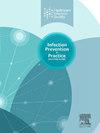Impact of the COVID-19 pandemic on alcohol-based hand rub consumption and hand hygiene compliance: a cross-sectional study using digital direct-observation tools in Slovakia
IF 1.9
Q3 INFECTIOUS DISEASES
引用次数: 0
Abstract
Background
Hand hygiene (HH) among healthcare professionals (HCPs) is a key component in ensuring safe and high-quality healthcare. Monitoring the Five moments for HH according to World Health Organization (WHO) guidelines remains the gold standard for compliance assessment. Proper HH is the most effective measure to prevent healthcare-associated infections (HAI).
Aim
This cross-sectional study aimed to quantify HH compliance and alcohol-based hand rub (ABHR) consumption among HCPS at the University Hospital Trnava in Slovakia and to compare results between the pre-pandemic and post-pandemic periods.
Methods
HH compliance was monitored during the pre-pandemic period (2018–2019) and the post-pandemic period (2022–2023). Compliance was assessed among different groups of HCPs – physicians, nurses and other healthcare personnel (e.g., physiotherapists, orderlies and students). Monitoring was conducted using WHO methodology and recorded via the OBSERVE app.
Findings
During the pre-pandemic period, overall HH compliance was 50.2% (95% CI, 48.7.-51.8), with nurses demonstrating the highest compliance rate. In the post-pandemic period, HH compliance remained nearly unchanged at (50.8%; 95% CI, 48.9–52.7). ABHR consumption increased significantly during the COVID-19 pandemic, peaking at 48.4 litres/1 000 patient days (PD), but declined to 31.5 litres/1 000 PD by 2023.
Conclusion
The COVID-19 pandemic positively influenced ABHR consumption and raised awareness of the importance of HH in clinical practice. However, overall HH compliance did not improve post-pandemic. Direct observation supported by a digital application proved to be an effective method for collecting HH compliance data.
COVID-19大流行对酒精洗手液消费和手部卫生合规的影响:在斯洛伐克使用数字直接观察工具进行的横断面研究
卫生保健专业人员(HCPs)的手部卫生(HH)是确保安全和高质量卫生保健的关键组成部分。根据世界卫生组织(世卫组织)准则监测健康的五个时刻仍然是合规评估的黄金标准。适当的卫生保健是预防卫生保健相关感染(HAI)的最有效措施。目的本横断面研究旨在量化斯洛伐克特尔纳瓦大学医院HCPS的HH依从性和酒精基洗手液(ABHR)消费量,并比较大流行前和大流行后时期的结果。方法在大流行前(2018-2019年)和大流行后(2022-2023年)监测shh的依从性。对不同组的HCPs——医生、护士和其他保健人员(如物理治疗师、护理员和学生)的依从性进行了评估。使用世卫组织方法进行监测,并通过OBSERVE应用程序进行记录。发现在大流行前,总体卫生保健依从率为50.2% (95% CI, 48.7 -51.8),护士的依从率最高。在大流行后时期,HH依从性几乎保持不变(50.8%;95% CI, 48.9-52.7)。在2019冠状病毒病大流行期间,ABHR消费量显著增加,峰值为48.4升/ 1000患者日(PD),但到2023年降至31.5升/ 1000患者日。结论新冠肺炎疫情对ABHR消费产生了积极影响,提高了人们对HH在临床中的重要性的认识。然而,大流行后,总体HH依从性并未改善。由数字应用程序支持的直接观察被证明是收集HH遵从性数据的有效方法。
本文章由计算机程序翻译,如有差异,请以英文原文为准。
求助全文
约1分钟内获得全文
求助全文
来源期刊

Infection Prevention in Practice
Medicine-Public Health, Environmental and Occupational Health
CiteScore
4.80
自引率
0.00%
发文量
58
审稿时长
61 days
 求助内容:
求助内容: 应助结果提醒方式:
应助结果提醒方式:


